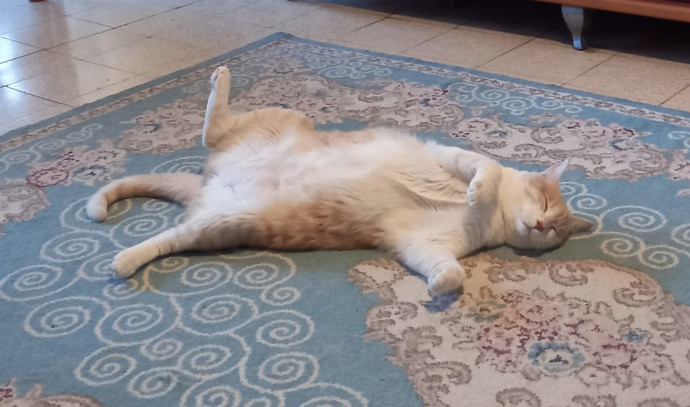As the waistlines of people in many countries expand and belts have to be expanded a few notches, it’s inevitable that their beloved pets will get fat as well. The incidence of feline obesity, which is commonly studied but mostly on weight loss rather than weight gain, continues to rise despite it being a preventable disease.
Cat owners want Kitty to be happy, but offering a cornucopia of food and snacks can have unintended consequences – endangering their health and shortening their longevity. Researchers from the University of Illinois Urbana-Champaign investigated what happens in the digestive system and gut microbiota when cats eat too much and have just published their findings in the Journal of Animal Science under the title “Effects of overfeeding on the digestive efficiency, voluntary physical activity levels, and fecal characteristics and microbiota of adult cats.”
There are about two million pet and street cats in Israel, and even those who live outside seem quite well fat from garbage cans and food left outside by “cat ladies.”
60% of cats are overweight
“About 60% of cats in the US are overweight, which can lead to health problems such as diabetes and chronic inflammation. While many studies have investigated feline weight loss, there has been little focus on the opposite process, which is also important. In this study, we wanted to learn more about the metabolic and gastrointestinal changes that occur as a result of overeating and weight gain in cats,” says study co-author and animal sciences Prof. Kelly Swanson of the College of Agricultural, Consumer and Environmental Sciences at the University of Illinois.
The study included 11 adult spayed female cats. They were fed standard dry cat food, and after two weeks of baseline measurements, they were allowed to eat as much as they wanted. The researchers collected blood and fecal samples at regular intervals and monitored physical activity.
Once the cats were able to overeat, they immediately increased their food intake substantially and started to gain weight. At the beginning of the study, their average body condition score (BCS) was 5.41 on a nine-point scale. After 18 weeks of overfeeding, it had increased to 8.27, corresponding to being 30% overweight. BCS is equivalent to body mass index (BMI) for humans, and six or above is considered overweight, Swanson said.
The researchers analyzed changes in fecal output, gastrointestinal transit time, digestive efficiency (nutrient digestibility), and microbiota bacterial composition over the study’s 20-week duration.
“We found that as cats ate more and gained weight, gastrointestinal transit time was reduced, and so was digestive efficiency. When the body gets less food, it will be more efficient in extracting nutrients. But when the amount of food increases, it passes through the digestive system faster and fewer nutrients are extracted in the process,” Swanson explained.
The researchers also found significant changes in gut microbial composition between the lean cats at baseline and after 18 weeks of weight gain. The relative abundance of Bifidobacterium, which has antimicrobial activity, inhibits pathogens, and stimulates the immune system, increased, while Collinsella, which degrades fiber and has been linked to pro-inflammatory diseases, decreased. These results are opposite to what has been measured in overweight humans and suggest that their association to weight gain is complex, Swanson noted. “The change in the gastrointestinal transit time was a novel finding and a potential reason for the change in fecal microbiota. Future studies should consider measuring transit time to better explain modifications to the microbiome of pets,” he added.
As the cats’ food consumption grew, so did their fecal output. In other words, as they ate more, they also pooped more. At the same time, fecal pH decreased, meaning that the stool became more acidic.“In humans, a low fecal pH indicates poor absorption of carbohydrates and fat. Our findings correlate with this, as reduced fecal pH aligned with higher food intake and reduced digestibility,” Swanson said.
The researchers also measured the cats’ activity level with a monitor attached to a collar. The cats were housed in a group setting where they were able to interact with each other and play with toys, except for the days when stool samples were collected.
“We expected that weight gain might lead to decreased physical activity, but we did not observe any consistent changes in activity level. However, this could vary with individual cats and their environment, and how much their owners interact with them,” Swanson stated.
Understanding the metabolic and gastrointestinal changes that occur with weight gain and obesity in pets could help with future prevention and treatment plans, the researchers concluded.
Pet owners who want to help their cats lose weight can use various strategies. Pet owners can restrict feeding to promote safe weight and fat loss in cats and encourage activity in their feline companions. For example, they can stimulate foraging by placing food around the home or use food puzzles during mealtime to promote engagement and mental enrichment.




